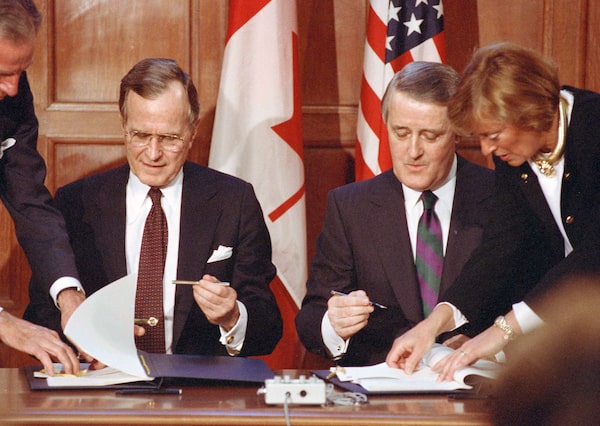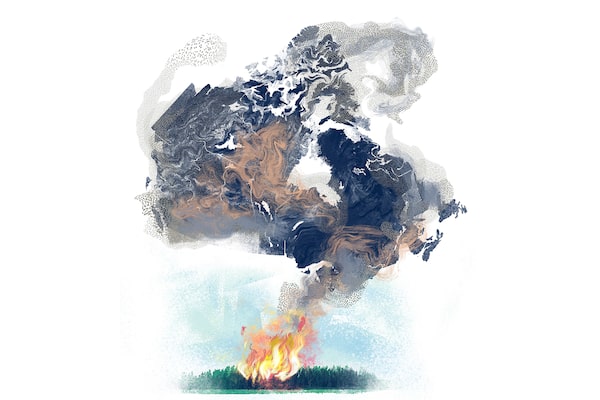If you’re reading this on the web or someone forwarded this e-mail newsletter to you, you can sign up for Globe Climate and all Globe newsletters here.
Good afternoon, and welcome to Globe Climate, a newsletter about climate change, environment and resources in Canada.
Brian Mulroney, Canada’s 18th prime minister, died at the age of 84 last week.
The Blue Tory will be remembered as the country’s greenest prime minister, for an environmental track record that still resonates today as the world grapples with biodiversity loss and climate challenges.
Bill Pristanski, who served in senior roles in the Mulroney administration, cited several major environmental achievements from that time, including the acid rain agreement. He also praised the 1987 Montreal Protocol, an international deal to phase out substances that deplete the ozone layer, a part of the Earth’s atmosphere that protects humans and other life from ultraviolet radiation.
Now, let’s catch you up on other news.

U.S. President George Bush and Canadian Prime Minister Brian Mulroney sign the Canada-United States Air Quality Agreement on Parliament Hill in Ottawa on March 13, 1991.Barry Thumma/The Associated Press
Noteworthy reporting this week:
- Alberta’s moratorium: Alberta banning renewables on prime land, declaring no-build zones for wind turbines. But, Danielle Smith’s new renewable energy restrictions won’t end industry in the province
- Analysis: Complaint from Capital Power shows tension around Ottawa’s plans to back carbon capture
- Photo essay: Life lessons from winter camping in the Canadian Shield
- Urban affairs: Toronto considers joining urban trend of converting public parking to housing
- CANDU reactors: AtkinsRéalis tries to rally Canadians around a new nuclear future
- Electric vehicles: EVs north of 60: Yukon a leader despite cold, remote location
- Restoration: Adaptive reuse or build-from-scratch? Experts say repurposing new buildings brings many benefits
- From The Narwhal: Chronic wasting disease threatens First Nations food security
A deeper dive
Green governance from Report on Business Magazine
For this week’s deeper dive, a collection of ROB magazine stories about the road to net zero for business.
Companies in the early stage of the net zero journey should read the most recent ROB magazine for a guide on how to get started.
“Yes, the transition to a no-carbon world is going to be painful. And absolutely, it’s going to be expensive,” writes Dawn Calleja in her editor’s note. “But what’s the alternative? What we need right now – what we needed two decades ago – isn’t more magical thinking. It’s bold leadership from corporations, yes, but also from governments and regulators. Industry needs guardrails.”
The magazine is focusing on leadership, highlighting Sustainalytics’ analysis of companies that are making progress in terms of disclosing key management indicators around the low-carbon transition and their climate investment plans.
“It’s far from perfect,” Calleja writes. “But we wanted to be both constructive and instructive: What are companies doing right, and where do they need to improve?”
Check out these stories from the magazine:
- Why good governance is greener: Fresh eyes on corporate boards tend to see environmental risks and opportunities in a new light
- Tipping point: Canada’s financial sector is lagging when it comes to real climate action. How do we catch up before it’s too late?
- Road to net zero ranking: A ranking of 30 Canadian companies with strong management leading them on the Road to Net Zero
- The Transition Rating: Introducing the Morningstar Sustainalytics Low-Carbon Transition Rating, a guide to understanding how Canadian companies are managing the shift to a net zero future

Illustration by Dushan Milic
What else you missed
- Labour, environment groups make plea for sustainable jobs bill to pass
- ‘Green’ hydrogen project in Newfoundland to get $128-million federal loan
- Montreal winter second-warmest on record, Environment Canada says
- Skiing or golf? Spring break choices during Canada’s ‘weirdest’ ski season
- EU cannot close borders to solar imports, energy policy chief says
Opinion and analysis
Kevin Yin: The anti-natural-gas camp is targeting the wrong problem
Duane Bratt: With Alberta renewables ban, business common sense goes out the window
Gus Carlson: Apple’s failed electric-vehicle move shows arrogance remains its core competency
Green Investing
Western miners hope superior ESG credentials can revive their fortunes amid devastating nickel crash
Nickel was one of the hottest commodities on the planet as recently as 2022. Analysts and mining executives then predicted blue-sky fundamentals for the critical mineral, based on the belief that demand for the electric car battery input would far outstrip global supply. But after a short-lived trading frenzy drove nickel to a record high in March, 2022, the commodity went into a steep decline. In the last year alone, nickel has tumbled almost 30 per cent to around US$17,500 a tonne.
To satisfy ESG-conscious investors, Canadian and Australia mining companies must meet a much higher bar than China or Indonesia. That includes electrifying their mining vehicle fleets, using carbon capture technology and adopting as many renewable energy sources as possible, steps that improve the impact on the environment, but which also often drive up costs.
- U.S. SEC to vote on long-awaited climate disclosure rule, notice says
Making waves
Pivot Green is once again accepting applications to the Canadian Youth Climate Action Award in partnership with the Small Change Fund. Their focus is to support young Canadians working together with other generations on positive, impactful ideas and actions that help address the climate anxiety and challenges of our times.
Applications for the 2024 award are now open. Deadline for applications is April 2, 2024.
Pivot Green connects and celebrates people, businesses and communities with stories and ideas to inspire restorative climate action and social justice.
Do you know an engaged individual? Someone who represents the real engines pursuing change in the country? Email us at GlobeClimate@globeandmail.com to tell us about them.
Photo of the week
Conservation biologists Kristine Ulvund and Craig Jackson from the Norwegian Institute for Nature Research and park rangers Olaf Bratland and Harald Normann Andersen, from the Norwegian Nature Inspectorate, release a young Arctic fox into the wild at Hardangervidda National Park near Geilo, Norway, on Feb. 8, 2024. As part of a state-sponsored program to restore Arctic foxes, Norway has been feeding the population for nearly 20 years.CRAIG JACKSON/Reuters
Guides and Explainers
- Want to learn to invest sustainably? We have a class for that: Green Investing 101 newsletter course for the climate-conscious investor. Not sure you need help? Take our quiz to challenge your knowledge.
- We’ve rounded up our reporters’ content to help you learn about what a carbon tax is, what happened at COP28, and just generally how Canada will change because of climate change.
- We have ways to make your travelling more sustainable and if you like to read, here are books to help the environmentalist in you grow, as well as a downloadable e-book of Micro Skills - Little Steps to Big Change.
Catch up on Globe Climate
- In B.C., taxpayers are at risk to cover mining cleanup costs
- The success story of a bear named Captain Hook
- Studying winter air pollution from the top of the CN Tower
- Canadian scientists seek the future of batteries
We want to hear from you. Email us: GlobeClimate@globeandmail.com. Do you know someone who needs this newsletter? Send them to our Newsletters page.